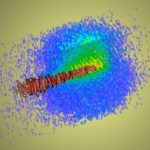Lonestar6, a Dell Technologies HPC system designed and deployed by the Texas Advanced Computing Center (TACC) at The University of Texas at Austin, is intended to perform about 3 quadrillion mathematical operations per second — or, in high-performance terminology, 3 petaflops. Lonestar6 is comprised of more than 800 Dell EMC PowerEdge C6525 servers with 3rd […]
Supercomputing DNA Packing in Nuclei at TACC
Aaron Dubrow writes that researchers at the University of Texas Medical Branch are exploring DNA folding and cellular packing with supercomputing power from TACC. “In the field of molecular biology, there’s a wonderful interplay between theory, experiment and simulation,” Pettitt said. “We take parameters of experiments and see if they agree with the simulations and theories. This becomes the scientific method for how we now advance our hypotheses.”
Supercomputing High Energy Cancer Treatments
Over at TACC, Aaron Dubrow writes that researchers are using TACC supercomputers to improve, plan, and understand the basic science of radiation therapy. “The science of calculating and assessing the radiation dose received by the human body is known as dosimetry – and here, as in many areas of science, advanced computing plays an important role.”
TACC’s Dan Stanzione on the Challenges Driving HPC
In this video from KAUST, Dan Stanzione, executive director of the Texas Advanced Computing Center, shares his insight on the future of high performance computing and the challenges faced by institutions as the demand for HPC, cloud and big data analysis grows. “Dr. Stanzione is the Executive Director of the Texas Advanced Computing Center (TACC) at The University of Texas at Austin. A nationally recognized leader in high performance computing, Stanzione has served as deputy director since June 2009 and assumed the Executive Director post on July 1, 2014.”
Podcast: Supercomputing Better Ways to Produce Gamma Rays
In this podcast, researchers from the University of Texas at Austin discuss how they are using TACC supercomputers to find a new way to make controlled beams of gamma rays. “The simulations done on the Stampede and Lonestar systems at TACC will guide a real experiment later this summer in 2016 with the recently upgraded Texas Petawatt Laser, one of the most powerful in the world. The scientists say the quest for producing gamma rays from non-radioactive materials will advance basic understanding of things like the inside of stars. What’s more, gamma rays are used by hospitals to eradicate cancer, image the brain, and they’re used to scan cargo containers for terrorist materials. Unfortunately no one has yet been able to produce gamma ray beams from non-radioactive sources. These scientists hope to change that.”
TACC’s Lonestar 5 Begins Full Production
Today the Texas Advanced Computing Center (TACC) announced that the Lonestar 5 supercomputer is in full production and is ready to contribute to advancing science across the state of Texas. Managed by TACC, the center’s second petaflop system is primed to be a leading computing resource for the engineering and science research community. “An analysis of strong-scaling on Lonestar 5 shows gains over other comparable resources,” said Scott Waibel, a graduate student in the Department of Geological Sciences at Portland State University. “Lonestar 5 provides the perfect high performance computing resource for our efforts.”
TACC to Speed Lonestar Supercomputer with DDN SFA14K
Today DDN announced that the Texas Advanced Computing Center has selected the company’s new SFA14KTM to deliver the performance, capacity and density needed for TACC’s latest Lonestar supercomputer. With 50 percent more cores and four times the performance of its predecessor, Lonestar 5 required the most advanced storage solution to support an exponential surge in big data resulting from hundreds of diverse research projects in astronomy, computational science, physics, bioinformatics, biomedicine, climate change, life sciences and more.









